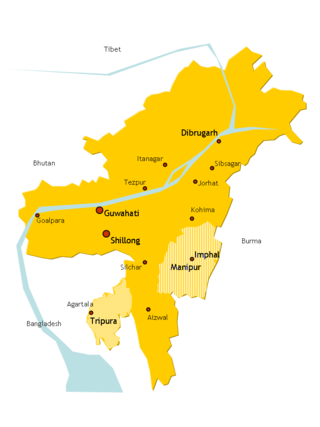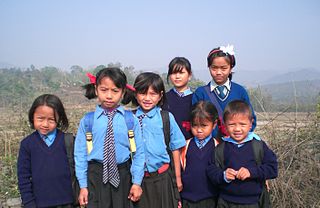This article has multiple issues. Please help improve it or discuss these issues on the talk page . (Learn how and when to remove these template messages)
|
Zomi nationalism is an independence movement in Chin State, Myanmar.
This article has multiple issues. Please help improve it or discuss these issues on the talk page . (Learn how and when to remove these template messages)
|
Zomi nationalism is an independence movement in Chin State, Myanmar.
This article needs to be updated. The reason given is: Updates needed past September 21, 1988.(November 2023) |
| Zomi conflict | |||||||
|---|---|---|---|---|---|---|---|
| Part of Insurgency in Northeast India &internal conflict in Myanmar | |||||||
| |||||||
| Belligerents | |||||||
| BNLF HPC-D MNF (1966–1986) | |||||||
| Commanders and leaders | |||||||
| Sao Meim Liam | ||||||
The British entered Zogam in 1777 and began colonial administration in 1890. In 1892 the British called the Chin-Lushai conference for the Chin and the Lushai, both hill tribes. The British favoured uniting the Chin and Lushai into one administration, but the Lushai rejected the plan. The Lushai hill tribe then took a new name, Mizo, a poetic word for the Zomi. In 1933, Vum Thu Muang founded the Chin National Union. In 1944 the various groups, such as Sukte Independence Army were raised in Burma. In 1947 modern Burma was assembled from five countries, including Chin, Kachin, federated Shan state, Karen state and Burma according to the Panglong agreement. This agreement outlined each state's right to be self-administered after ten years from the date of agreement. However, the union of Burma was politically collapsing and the agreement fell apart.
In 1960, the Chin Liberation Army was founded by Tun Kho Pum Baite to re-unify the Chin people while the Mizo National Front (MNF) strove for Mizo independence. MNF ended with the Mizoram state's creation by the Indian government. This movement did not cover all of Zogam. The Zomi Revolutionary Army was then created. Now the Hill people (Zomi) re-unification group is the Zomi Revolutionary Army. [1]
The 8888 uprising took place in 1988. Students were protesting against the Burmese government. Zomi students were involved and founded the Chin National Army (CNA). The CNA continued its campaign against the Burmese government for about six months, until it was destroyed and many corpses were recovered from their camps. Some members went into hiding, while others founded small armed groups. The CNA was rejected by the Zomi National Congress.
After a few months, the CNA asked for a ceasefire agreement with the Burmese government.

Mizoram is a landlocked state in northeast India, with Aizawl as its seat of government and largest city. Within India's northeast region, it is the southernmost state, sharing borders with three of the Seven Sister States, namely Tripura, Assam and Manipur, and also shares a 722-kilometre (449 mi) border with the neighbouring countries of Bangladesh and Myanmar. The state spans over an area of approximately 21,087 square kilometres, of which approximately 91% is forested. With an estimated population of 1.25 million in 2023, it is the second least populous state in the country.

Chin State is a state in western Myanmar. Chin State is bordered by Sagaing Division and Magway Division to the east, Rakhine State to the south, the Chittagong Division of Bangladesh to the west, and the Indian states of Mizoram to the west and Manipur to the north. The population of Chin State is about 488,801 according to the 2014 census, and its capital city is Hakha.
Mizo Union was the first political party in Mizoram, northeast India. It was founded on 6 April 1946 at Aizawl as the Mizo Common People's Union. At the time of independence of India from the british rule in india in 1947, the party was the only political force in the Lushai Hills. It won the first Mizoram District Council general election under the new Indian Union in 1951, and consecutively in 1957, 1962 and 1966.

The Insurgency in Northeast India involves multiple separatist militant groups operating in some of India's northeastern states, which are connected to the rest of India by the Siliguri Corridor, a strip of land as narrow as 14.29 miles (23.00 km) wide.

The Mizo people, historically recorded as the Lushais, are an ethnic group native to the state of Mizoram in India and neighbouring states of Northeast India. They speak the Tibeto-Burman language of Mizo, the official language and lingua franca of Mizoram. The state is the second most literate state in India, at more than a rate of 90%.
The Chin people are an ethnic group native to the Chin State and Rakhine State of Myanmar. Strictly speaking, the term "Chin" only refers to the 53 sub-tribes of the Chin ethnic group, divided and recognized by the Burmese government. They speak the Kuki-Chin-Mizo languages, which are often mutually unintelligible but are closely related.
The Paite people are an ethnic group in Northeast India, mainly living in Manipur and Mizoram. The Paites are recognized as a scheduled tribe in these two states. They are part of the Kuki-Zo people, but prefer to use the Zomi identity. "Guite" is a major clan of the Paite people.

The history of Mizoram encompasses the history of Mizoram which lies in the southernmost part of northeast India. It is a conglomerate history of several ethnic groups of Chin people who migrated from Chin State of Burma. But information of their patterns of westward migration are based on oral history and archaeological inferences, hence nothing definite can be said. The recorded history started relatively recently around the mid-19th century when the adjoining regions were occupied by the British monarchy. Following religious, political and cultural revolutions in the mid-20th century majority of the people agglomerated into a super tribe, Mizo. Hence the officially recognised settlement of the Mizos became Mizoram.

The Kuki people are an ethnic group in the Northeastern Indian states of Manipur, Nagaland, Assam, Meghalaya, Tripura and Mizoram, as well as the neighbouring countries of Bangladesh and Myanmar. The Kukis form one of the largest hill tribe communities in Northeast India, along with the adjoining regions of Bangladesh and Myanmar. In Northeast India, they are present in all states except Arunachal Pradesh. The Chin people of Myanmar and the Mizo people of Mizoram are kindred tribes of the Kukis. Collectively, they are termed the Zo people.
Zo is a Northern Kuki-Chin-Mizo language originating in western Burma and spoken also in Mizoram and Manipur in northeastern India.
Guite is the progenitor clan of Zomi people, also called Chin in Myanmar, Mizo, or Paite, or even Kuki in India. According to Zam, Nigui Guite is the elder brother of the ancestral fathers of the Thadou people, namely Thangpi, Sattawng, and Neirawng. This genealogy was recently inscribed on the tribal memorial stone at Bungmual, Lamka in the presence of each family-head of the three major clans, Doungel, Kipgen, and Haokip, on August 7, 2011. Some historians, like Shakespeare, assumed Lamlei was the Nigui Guite himself but the Guites themselves recounted Tuahciang, the father of Lamlei, as the son of Nigui Guite instead, in their social-religious rites. Regarding Guite as the born son of Songthu and his sister, Nemnep, it was the practice of ancient royalty to issue royal heir and also to keep their bloodline pure instead. Depending on local pronunciation, the clan was also called by different names such as Nguite or Vuite, Gwite, Nwite, Paihte by the Lushei. In accord with the claim of their solar origin, the Guite clan has been called nampi, meaning noble or major or even dominant people, of the region in local dialect in the past.
The Lai people mainly inhabit the southern parts of Chin Hills in Myanmar's Chin State, in the townships of Falam, Thantlang and Hakha. They are also found in the Lawngtlai district of Mizoram, India, where they have been granted the Lai Autonomous District Council. Outside this area they are scattered in Mizoram and in Manipur. Their languages "Laizo Lai" and "Hakha Lai" are classified as Central Kuki-Chin languages.

Zogam known as Zoland, Zoram, Lushai Hills, Kuki Hills, lies in the northwest corner of the Mainland Southeast Asia landmass. This is the traditional ancestry homeland of the Zo people or Zomi who lived in this area before the colonial period under British rulership.
The Tedim people, also called Tedim Chins and Tiddim (Hai-Dim) people, are a Zomi ethinic group, part of the Chin people, primarily inhabiting the Tedim Township in the Chin State of Myanmar. They speak the Tedim language, a northern Kuki-Chin language.

The Zomi Revolutionary Army (ZRA) is an armed Zomi nationalist militant group formed in 1997, following an increase in ethnic tensions between the Kuki people and the Paites tribe in Churachandpur district of Manipur, India. Its parent organisation, the Zomi Re-unification Organisation, was founded in April 1993.
The Zo people is a term to denote the ethnolinguistically related speakers of the Kuki-Chin languages who primarily inhabit northeastern India, western Myanmar, and southeastern Bangladesh.
The Mizoram Peace Accord, 1986 was an official agreement between the Government of India and the Mizo National Front (MNF) to end insurgency and violence in Mizoram, India, that started in 1966. The Mizo National Front was an organisation of Mizo secessionists led by Laldenga to fight for independence from India. The movement was basically due to lack of support from the government during the great famine in Mizoram in the late 1950s. Political insurgency and social unrest ensued in the next decades. After a number of negotiations, the document titled Mizoram Accord, 1986: Memorandum of Settlement was finally signed on 30 June 1986. It was signed by Laldenga for MNF, R.D. Pradhan, Home Secretary, Government of India, and Lalkhama, Chief Secretary, Government of Mizoram. It is remarked as the most and only successful peace agreement in India after its independence from British Empire in 1947.

The hill tribes of Northeast India are hill people, mostly classified as Scheduled Tribes (STs), who live in the Northeast India region. This region has the largest proportion of scheduled tribes in the country.

Aizawl, formerly known as Aijal, is the capital city and the most populous city of Mizoram, India. It is also the fourth largest city in northeast India, after Imphal and Agartala. It is situated atop a series of ridges, with an average elevation of around 1,132 metres above sea level. In 2024, the city has an estimated population of 405,000 people.